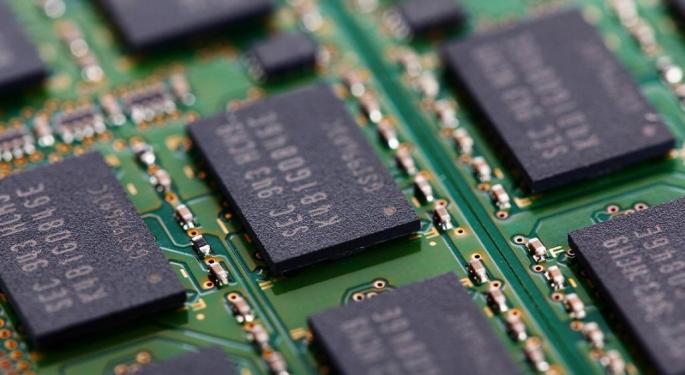Have You Ever Wondered How Intel Chips Are Made?
Most PC's are still powered by the chips of Intel Corporation (NASDAQ: INTC), the world's largest manufacturer of microprocessors. But, have you ever wondered how the company makes a chip?
A Bloomberg report said chips are made by creating tiny patterns on a polished 12-inch silicon disk, in part by using a process called photolithography and depositing superthin layers of materials on top.
Bloomberg said these wafers are kept in sealed, microwave oven-size pods called "foups" that are carried around by robots—hundreds of robots, actually—running on tracks overhead, taking the wafers to various tools.
"The air inside a foup is class 1, meaning it probably contains no particles at all. Periodically, the wafer is washed using a form of water so pure it isn't found in nature. It's so pure it's lethal. If you drank enough of it, it would pull essential minerals out of your cells and kill you."
Over the next three months, these wafers will be transformed into microprocessors.
"They'll make their way through more than 2,000 steps of lithography, etching, material application, and more etching. Each will then be chopped up into a hundred or so thumbnail-size "dies," each of which will be packaged in a ceramic enclosure. If everything functions properly, none of the 100,000 or so people who work at Intel will ever touch them."
The result is the Intel Xeon E5 v4, the company's latest server chip and the engine of the Internet.
The report noted that simply building a fab capable of producing a chip like the E5 costs at least $8.5 billion, according to Gartner. This excludes the costs of research and development ($2 billion-plus) or of designing the circuit layout (more than $300 million). Even modest "excursions"—Intel's euphemism for screw-ups—can add hundreds of millions of dollars in expense. The whole process can take five years or more.
No wonder, Bloomberg reports that a top-of-the-line E5 is the size of a postage stamp, retails for $4,115, and uses about 60 percent more energy per year than a large Whirlpool refrigerator.
Intel has been hit by falling PC sales due to the rise of smartphones, but it's still the world's largest chipmaker, and sells 99 percent of the chips that go into servers, according to IDC.
Intel's chips are key to servers of companies such as Amazon.com, Inc. (NASDAQ: AMZN) and Microsoft Corporation (NASDAQ: MSFT).
The report highlighted that the electricity needed to run and cool servers is by far the biggest expense at the average server farm. If Intel can produce power-saving chips, then there will be no hesitation from the companies to upgrade again and again.
"Our customers expect that they will get a 20 percent increase in performance at the same price that they paid last year," says Diane Bryant, an Intel executive vice president and general manager of the company's data center business told Bloomberg. "That's our mantra."
© 2025 Benzinga.com. Benzinga does not provide investment advice. All rights reserved.



